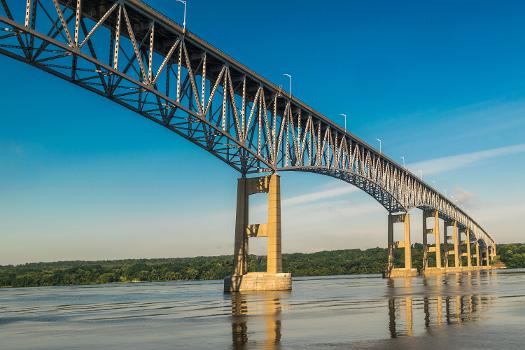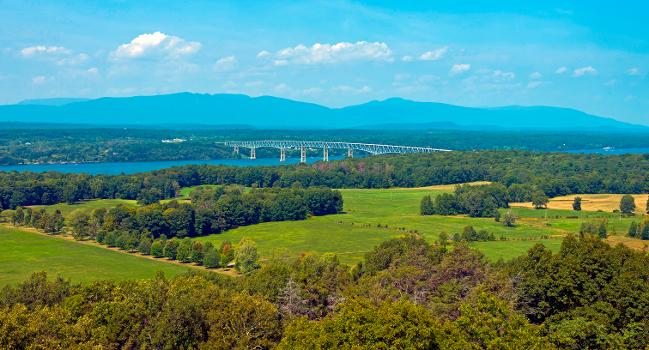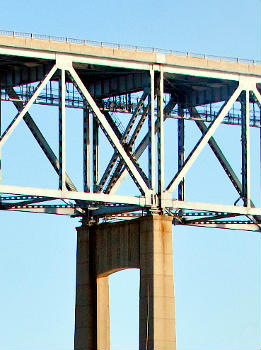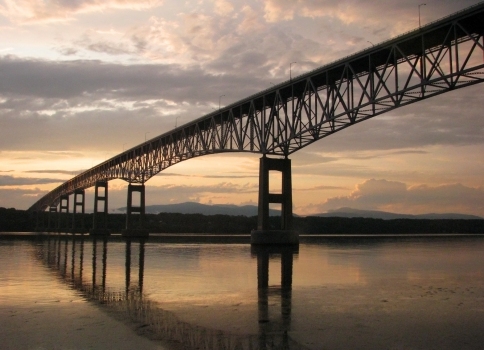General Information
| Other name(s): | George Clinton Kingston-Rhinecliff Bridge |
|---|---|
| Beginning of works: | 1954 |
| Completion: | 2 February 1957 |
| Status: | in use |
Project Type
| Structure: |
Deck truss bridge |
|---|---|
| Function / usage: |
Road bridge |
| Material: |
Steel bridge |
| Structure: |
Continuous truss bridge |
| Support conditions: |
for registered users |
| Structure: |
Subdivided Warren truss bridge Non-parallel chord truss bridge |
| Material: |
Structurae Plus/Pro - Subscribe Now! |
| Secondary structure(s): |
Structurae Plus/Pro - Subscribe Now! |
Location
| Location: |
East Kingston, Ulster County, New York, USA Rhinebeck, Dutchess County, New York, USA |
|---|---|
| Crosses: |
|
| Coordinates: | 41° 58' 39.36" N 73° 56' 45.49" W |
Technical Information
Dimensions
| total length | 2 375.3 m | |
| main spans | 243.8 m | |
| clearance | 46.3 m |
Cost
| cost of construction | United States dollar 17 500 000 |
Materials
| piers |
reinforced concrete
|
|---|---|
| truss |
steel
|
Chronology
| 1 July 1954 | Construction started. |
|---|---|
| 2 February 1957 | Opened to traffic |
Excerpt from Wikipedia
The Kingston–Rhinecliff Bridge or George Clinton Memorial Bridge is a continuous under-deck truss bridge that carries NY 199 across the Hudson River in New York State north of the City of Kingston and the hamlet of Rhinecliff. It was opened to traffic on February 2, 1957 as a two-lane (one in each direction) bridge, although it was not actually complete. Formal opening was May 11, 1957. The original cost was $17.5 million.
The bridge, owned by the New York State Bridge Authority (NYSBA), carries two lanes of traffic and approximately 17,000 vehicles per day. It was designed by David B. Steinman and the builders were Harris Structural Steel and Merritt-Chapman & Scott Corporation, and is the second northernmost, and second newest, of the 5 bridges that NYSBA owns and operates. The bridge has two main spans, since there is an east and west channel in the Hudson River at this point.
Development
Planning for a bridge in this general area to replace the ferry service, which was viewed as sporadic and unreliable, (there were no Hudson bridges for a half-hour or more drive time in either direction) began in the early 1940s. The site for the bridge, as originally proposed was between Kingston Point and downtown Rhinebeck, and the design was initially a suspension bridge almost identical in appearance to the Mid-Hudson Bridge. When the site was relocated about 3 miles (4.8 km) northward, there was no stable bedrock for anchorages, so the design was changed to a continuous under-deck truss. Construction commenced in 1954. When the Newburgh-Beacon Bridge was proposed, provisions were inserted in the enabling legislation that construction on that bridge could not commence until the Kingston–Rhinecliff was completed.
Like all NYSBA bridges, the Kingston–Rhinecliff is a toll bridge, with the toll set at $1.50 for eastbound automobiles and other 2 axle vehicles. Westbound traffic is not tolled. Originally, tolls were collected in both directions. In August 1970, the toll was abolished for westbound drivers, and at the same time, eastbound drivers saw their tolls doubled. The tolls of eleven other New York–New Jersey and Hudson River crossings along a 130-mile (210 km) stretch, from the Outerbridge Crossing in the south to the Rip Van Winkle Bridge in the north, were also changed to eastbound-only at that time.
In 2000 the state ceremonially renamed the bridge after George Clinton, New York's first Governor, fourth Vice President of the United States and a resident of the Hudson Valley.
Tolls
A $1.50 toll is collected in the eastbound direction for all cars. E-ZPass users pay a $1.25 toll. There is no toll collected for westbound traffic.
Text imported from Wikipedia article "Kingston–Rhinecliff Bridge" and modified on July 22, 2019 according to the CC-BY-SA 4.0 International license.
Participants
Relevant Web Sites
- About this
data sheet - Structure-ID
20001720 - Published on:
12/08/2001 - Last updated on:
03/11/2023


.jpg)

.jpg)





